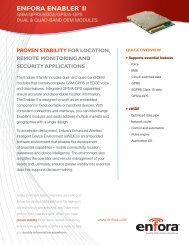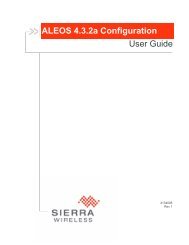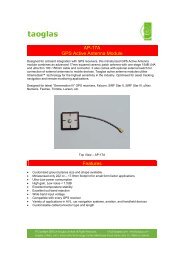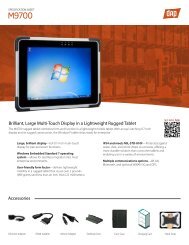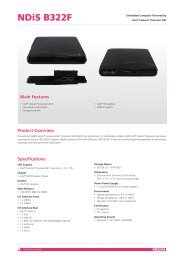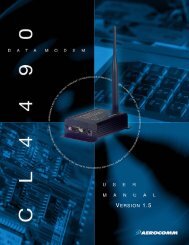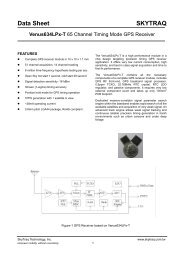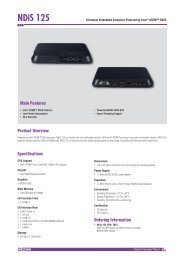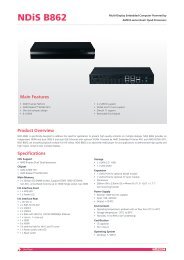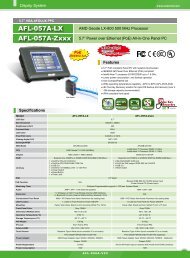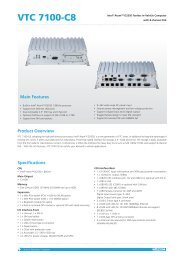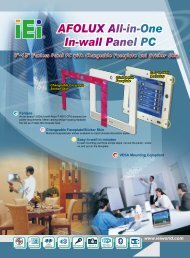Aerocomm AC4868.pdf - HEAnet Mirror Service
Aerocomm AC4868.pdf - HEAnet Mirror Service
Aerocomm AC4868.pdf - HEAnet Mirror Service
Create successful ePaper yourself
Turn your PDF publications into a flip-book with our unique Google optimized e-Paper software.
AC4868-250 TRANSCEIVER MODULE 1<br />
The compact AC4868-250 868MHz transceiver can replace miles of cable in harsh industrial environments. Using field-proven<br />
FHSS technology which needs no additional FCC licensing in the Americas, OEMs can easily make existing systems wireless<br />
with little or no RF expertise.<br />
AC4868-250 FEATURES<br />
OVERVIEW<br />
NETWORKING AND SECURITY<br />
• Drop-in replacement for AC4868-250 900 MHz & AC4424 2.4 GHz product families<br />
• Generic I/O digital lines and integrated DAC/ADC functions<br />
• Retries and Acknowledgements<br />
• Low latency and high throughput<br />
EASY TO USE<br />
• Software selectable interface baud rates from 1200 bps to 57.6 kbps<br />
• Low cost, low power and small size ideal for high volume, portable and battery powered<br />
applications<br />
• All modules are qualified for Industrial temperatures (-40°C to 80°C)<br />
• Advanced configuration available using AT commands<br />
The AC4868-250 is a member of AeroComm’s ConnexRF OEM transceiver family. The AC4868-250 is designed for<br />
integration into OEM systems operating under European ETSI regulations for the 868 - 870 MHz band.<br />
AC4868-250 transceivers provide an asynchronous TTL/RS-485 level serial interface for OEM Host communications.<br />
Communications include both system and configuration data. The Host supplies system data for transmission to<br />
other Host(s). Configuration data is stored in the on-board EEPROM. All frequency hopping, synchronization, and RF<br />
system data transmission/reception is performed by the transceiver.<br />
To boost data integrity and security, the AC4868-250 uses AeroComm’s field-proven FHSS technology featuring<br />
optional Data-Encryption Standards (DES). Fully transparent, these transceivers operate seamlessly in serial cable<br />
replacement applications.<br />
AC4868-250 transceivers can operate in a Point-to-Point, Point-to-Multipoint, Client-Server, or Peer-to-Peer<br />
architecture. One transceiver is configured as a Server and there can be one or many Clients. To establish<br />
synchronization between transceivers, the Server emits a beacon. Upon detecting a beacon, the Client transceiver<br />
informs its Host and an RF link is established.<br />
This document contains information about the hardware and software interface between an AeroComm AC4868-250<br />
transceiver and an OEM Host. Information includes the theory of operation, specifications, interface definition,<br />
configuration information and mechanical drawings. The OEM is responsible for ensuring the final product meets all<br />
appropriate regulatory agency requirements listed herein before selling any product.<br />
Note: Unless mentioned specifically by name, the AC4868-250 modules will be referred to as the “radio” or<br />
“transceiver”. Individual naming is used to differentiate product specific features. The host (PC/Microcontroller/Any<br />
device to which the AC4868-250 module is connected) will be referred to as “OEM Host”.<br />
www.aerocomm.com



